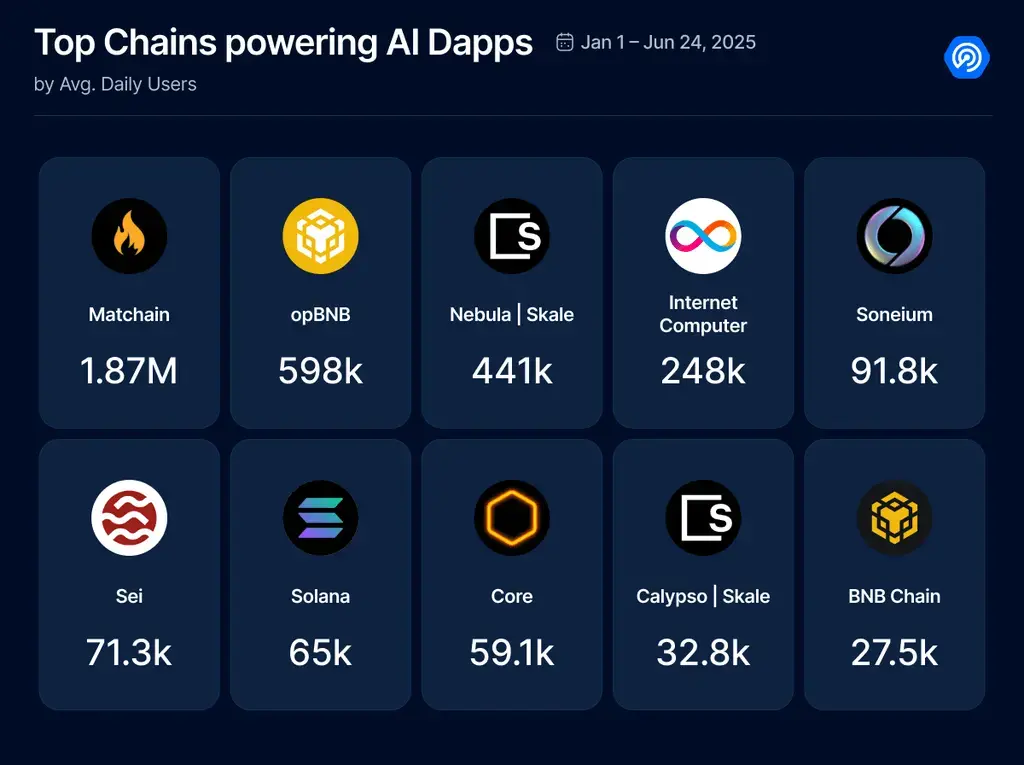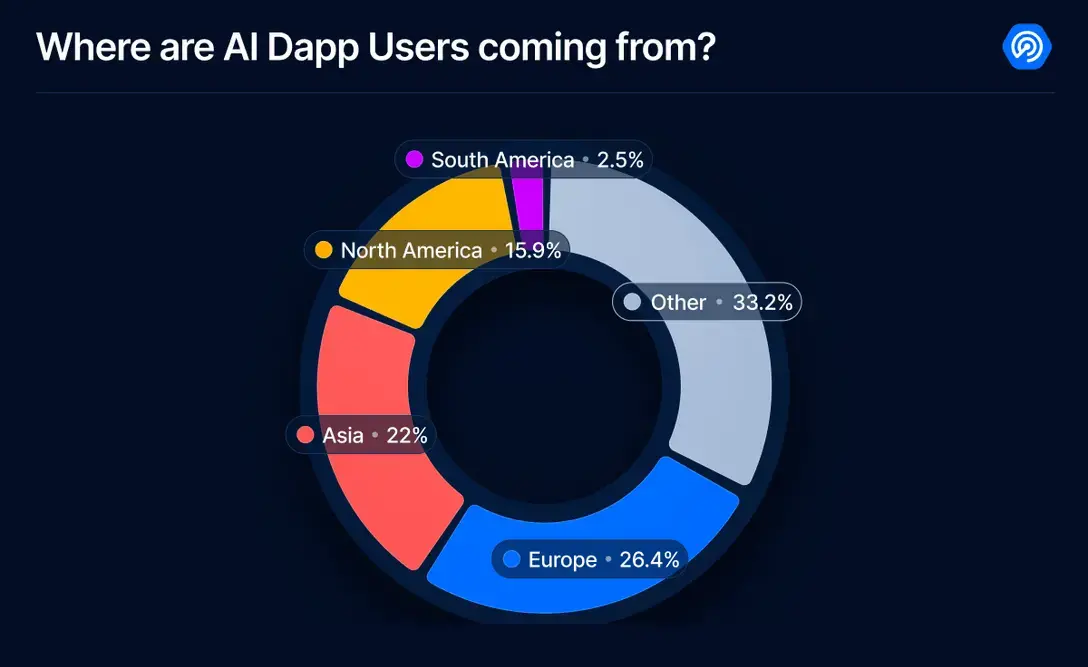Original Title: AI Agents Become a Top Web3 Investment with $1.39B Raised
Original Author: Sara Gherghelas, Dappradar
Original Translation: Felix, PANews
Since the beginning of 2025, on-chain activities related to AI have surged by 86%, with the number of daily active unique wallets (dUAW) reaching approximately 4.5 million. This has elevated AI's dominance to 19%, second only to gaming at 20%. Considering its market share was only 9% at the beginning of the year, this is a significant change.
This explosive growth is not merely due to hype; it reflects a structural change in how users interact with dApps. Whether through DeFi, social agents, or autonomous gaming assistants, AI agents are becoming a new layer of on-chain interaction. They do not replace users but rather expand their capabilities, enabling automation, optimization, and representation in interactions.
Data supports this assertion: AI has dominated discussions in Web3 over the past month and is likely to define the direction of its next phase of development. This report explores the evolution of AI agents, their use cases, the role of tokens, and the scale of capital supporting this shift.
Key Points
- In June, AI's on-chain dominance rose from 9% in January to 19%, with trading activity increasing by 86% and daily active unique wallets reaching 4.5 million.
- As of June 2025, AI agent projects have raised $1.39 billion, a 9.4% increase compared to the total funding for all of 2024.
- Since November 2024, 17,124 agents have launched on Virtuals Protocol, with an average of over 85 new agents added daily.
- Although the market capitalization of AI tokens has decreased by 64% from the peak in early June, it currently stands at $5.9 billion, with a 24-hour trading volume of $1.4 billion.
- Europe (26.2%) and Asia (21.9%) are the regions with the highest usage of AI dApps, followed by North America (15.8%).
1. What are AI Agents?
AI agents are autonomous software programs capable of executing tasks, making decisions, or interacting with users based on goals, prompts, or real-time data. Traditional AI agents cover industries such as finance, healthcare, or customer service, while the Web3 ecosystem is giving rise to crypto-native agents with unique capabilities and roles.
In Web3, AI agents are evolving towards specialization. Some act as on-chain DeFi agents, executing trades, managing yield strategies, or serving as portfolio "managers." Others are social agents, representing users in decentralized social applications, managing profiles, and even responding to messages and interactions. In the gaming sector, a new class of native gaming agents has emerged, trained on game backgrounds, mechanics, or player behaviors, serving as helpful guides or even opponents.
This is not just theoretical. According to cookie.fun data tracking the agent economy, there are currently 1,748 AI agents active in various environments. Since its launch in November 2024, Virtuals Protocol, which allows users to create and deploy their own AI agents, has seen over 17,000 agents go live. The actual number may be even higher, as multiple chains are currently prioritizing the infrastructure for creating, training, and deploying AI agents.
The agent economy is taking shape and developing rapidly.
2. AI Agent Tokens: Utility, Hype, and Capital
In Web3, most AI agents are not launched independently but come with tokens. The role of these tokens depends on the project's vision and can serve various functions. In many cases, they are designed to support community governance, provide access to premium features, or act as a fundraising mechanism, especially since training and maintaining AI agents still requires significant resources.
For others, tokens are merely a capitalization strategy, a way to gain liquidity, reward early adopters, or leverage market momentum. In some cases, they resemble meme coins dressed in AI clothing, issued around vague agent narratives, lacking technical substance, and merely riding the wave of speculative enthusiasm.
Despite the noise in the market, the AI agent token market has made remarkable progress. As of this writing, the total market capitalization of AI-related tokens has reached $5.9 billion, accounting for 0.18% of the entire crypto market. The daily trading volume over the past 24 hours is also quite substantial, exceeding $1.4 billion.
However, the recent trend is not optimistic. Earlier this month, the market capitalization of the AI agent sector was $16.6 billion, indicating a 64% decline in just a few weeks. This drop reflects broader market conditions rather than just attitudes towards AI. But it also highlights the volatility inherent in early-stage sectors, where token speculation often outweighs actual utility.
AI agents are here to stay. But what about their tokens?
3. Top Blockchains Empowering AI dApps
While AI agents are often the visible layer for interacting with users, executing trades, or providing in-game assistance, their success largely depends on the underlying infrastructure. Blockchains that support high-capacity AI dApps are effectively laying the groundwork for the deployment, training, and interaction of AI agents.
From January 2025 to June 24, the following blockchains have shown the most activity in AI dApp usage:

Matchain leads with nearly 1.9 million daily active users, indicating that AI infrastructure is thriving, driven by social or agent-oriented dApps. opBNB and Nebula follow closely, both showing strong usage rates related to lightweight to gamified AI services.
While not all of these dApps currently deploy agents, the development momentum is evident. As the AI agent framework matures, these blockchains may witness the next wave of autonomous agents, whether in DeFi, gaming, or social applications.
We may still be in the infrastructure-building phase of the AI agent boom, and these networks are leading the way.
4. Where Are the Users Coming From?
AI agents may exist on-chain, but their users are spread across the globe. Understanding the sources of user participation helps clarify adoption trends, localization needs, and potential market opportunities.
From January to June 2025, according to Dappradar traffic data, Europe leads in interactions with AI-related dApps, accounting for 26.2%. Asia follows with 21.9%, and North America comes next at 15.8%. South America has a smaller share at 2.5%, but its user base is steadily growing. Interestingly, 33% of the traffic comes from unspecified or hard-to-categorize regions, collectively referred to as "others."

This global distribution indicates that AI agents are not confined to a specific region. Whether it's DeFi agents managing trades in Asia, social agents representing users in Europe, or gaming partners interacting with players in North America, the demand is diverse and increasingly cross-continental.
As the industry matures, we can expect to see more localized agent behaviors, improved language modeling, and even agents with region-specific personalities. Currently, the competitive landscape is vast, and the race for user attention is global.
5. Capital Flowing into AI Agents
The AI narrative continues to dominate headlines and funding rounds. While centralized AI giants like OpenAI, Anthropic, and Mistral have raised billions, the AI agent economy in Web3 is also starting to gain attention.
As of 2025, AI agent projects have raised $1.39 billion, a 9.4% increase from 2024. This indicates that investors are increasingly convinced that autonomous on-chain agents could become the next frontier. Although this figure is still far below the investment amounts in centralized AI, it is noteworthy that the funding in the AI agent space is now comparable to or even surpasses that of other Web3 segments like blockchain gaming.
This comparison is significant. Centralized AI investment still dominates, with hundreds of billions flowing into model development, chips, and infrastructure. However, in the Web3 space, investors are increasingly viewing AI agents as a new "primitive" that can reshape how users interact with protocols, navigate dApps, and even automate personal finance strategies.
This momentum is building. If it continues, 2025 could be the year AI agents attract more funding than any other Web3 vertical.
6. Conclusion
The rise of AI agents marks a profound shift in how users interact with decentralized systems. From DeFi traders and social partners to native gaming assistants, agents are rapidly evolving from experimental bots to infrastructure.
These numbers corroborate this assertion. Since late 2024, over 17,000 virtual agents have gone live. Even in a market downturn, the AI token market size remains at $5.9 billion and continues to grow. Just this year, startups focused on agents have raised $1.39 billion. Moreover, user participation is global, showing strong performance in Europe, Asia, and North America.
However, challenges remain. Many tokens are driven more by hype than utility. Not all agents can deliver on the promise of autonomy. Additionally, cross-chain infrastructure remains uneven. But as tools mature and practical use cases proliferate, the agent economy is approaching a new baseline where interactions with on-chain AI are no longer exceptions but the norm.
The competition to build smarter agents, more robust ecosystems, and clearer standards has already begun. And we are still in the early stages.
免责声明:本文章仅代表作者个人观点,不代表本平台的立场和观点。本文章仅供信息分享,不构成对任何人的任何投资建议。用户与作者之间的任何争议,与本平台无关。如网页中刊载的文章或图片涉及侵权,请提供相关的权利证明和身份证明发送邮件到support@aicoin.com,本平台相关工作人员将会进行核查。




